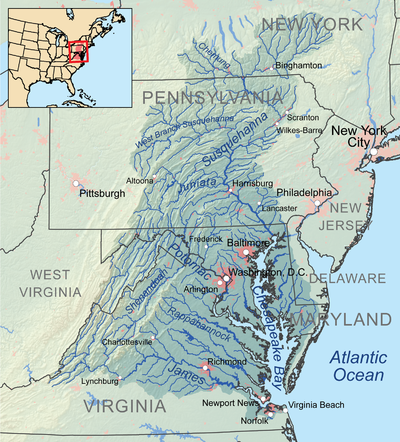Difference between revisions of "Multi-State Approaches to Environmental Restoration in the Chesapeake Bay and Water Diplomacy Framework Opportunities"
| [checked revision] | [unchecked revision] |
| Line 6: | Line 6: | ||
|Area=165759.24 | |Area=165759.24 | ||
|Geolocation=38.5733650426, -76.3703615963 | |Geolocation=38.5733650426, -76.3703615963 | ||
| − | |Issues= | + | |Issues={{Issue |
| + | |Issue=The bay’s environmental quality, especially water quality, is degraded. How should those conditions be restored? | ||
| + | |Issue Description=There are competing interests among and within jurisdictions. Voluntary, interstate agreements have been the primary approach, with minimal results. Eventually, those agreements led to a total maximum daily load (TMDL). | ||
| + | |||
| + | Stakeholders | ||
| + | • States (Virginia, Maryland, Delaware, West Virginia, Pennsylvania, New York) | ||
| + | • Washington, D.C. | ||
| + | • Federal Government (United States Environmental Protection Agency (US EPA)) | ||
| + | • Chesapeake Bay Commission | ||
| + | • Chesapeake Bay Foundation | ||
| + | • Interest Groups | ||
| + | |NSPD=Water Quality; Ecosystems; Governance | ||
| + | |Stakeholder Type=Federated state/territorial/provincial government, Sovereign state/national/federal government, Local Government, Non-legislative governmental agency, Environmental interest, Industry/Corporate Interest, Community or organized citizens | ||
| + | }}{{Issue}} | ||
|Key Questions={{Key Question | |Key Questions={{Key Question | ||
|Subject=Transboundary Water Issues | |Subject=Transboundary Water Issues | ||
Revision as of 11:21, 21 May 2017
| Geolocation: | 38° 34' 24.1142", -76° 22' 13.3017" |
|---|---|
| Total Population | 1717,000,000 millionmillion |
| Total Area | 165759.24165,759.24 km² 63,999.643 mi² km2 |
| Climate Descriptors | Humid mid-latitude (Köppen C-type), Continental (Köppen D-type) |
| Predominent Land Use Descriptors | agricultural- cropland and pasture, agricultural- confined livestock operations, urban, urban- high density |
| Important Uses of Water | Domestic/Urban Supply, Fisheries - wild, Livestock, Other Ecological Services, Recreation or Tourism |
| Water Features: | Chesapeake Bay, Atlantic Ocean, Susquehanna River, Potomac River, James River |
| Riparians: | The United States of America |
Contents
[hide]Summary
Natural, Historic, Economic, Regional, and Political Framework
Geographic Background
Issues and Stakeholders
The bay’s environmental quality, especially water quality, is degraded. How should those conditions be restored?
NSPD: Water Quality, Ecosystems, Governance
Stakeholder Types: Federated state/territorial/provincial government, Sovereign state/national/federal government, Local Government, Non-legislative governmental agency, Environmental interest, Industry/Corporate Interest, Community or organized citizens
There are competing interests among and within jurisdictions. Voluntary, interstate agreements have been the primary approach, with minimal results. Eventually, those agreements led to a total maximum daily load (TMDL).
Stakeholders • States (Virginia, Maryland, Delaware, West Virginia, Pennsylvania, New York) • Washington, D.C. • Federal Government (United States Environmental Protection Agency (US EPA)) • Chesapeake Bay Commission • Chesapeake Bay Foundation
• Interest Groups
Analysis, Synthesis, and Insight
Individuals may add their own Analysis, Synthesis, and Insight (ASI) to a case. ASI sub-articles are protected, so that each contributor retains authorship and control of their own content. Edit the case to add your own ASI.
Learn moreNo ASI articles have been added yet for this case
Key Questions
Transboundary Water Issues: What kinds of water treaties or agreements between countries can provide sufficient structure and stability to ensure enforceability but also be flexible and adaptable given future uncertainties?
no description entered






